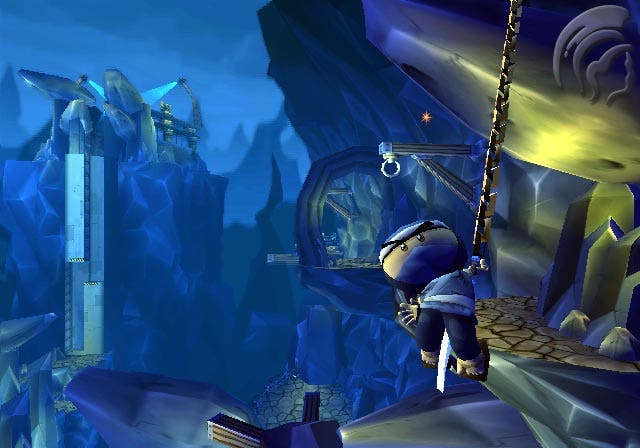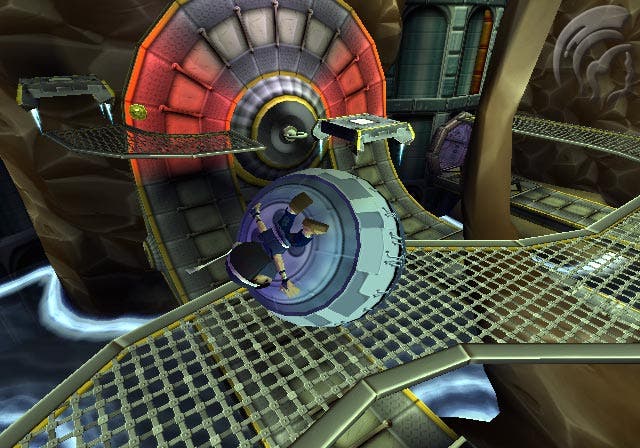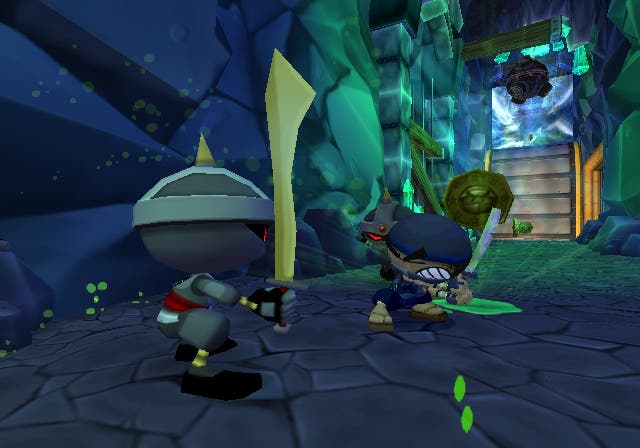I-Ninja
Argonaut's homegrown platform property might surprise you.
Argonaut is certainly a versatile little developer these days. When it's not producing million-selling licensed Harry Potter titles for EA, or underrated first-person shooters like SWAT: Global Strike Team, it's busy developing its own intellectual property like I-Ninja, a platform game that draws on even more genres for inspiration than the likes of Jak II and Ratchet & Clank 2. After all, even they couldn't boast a Punch-Out tribute boss, aerial katana combat and Monkey Ball/Marble Madness-inspired robot construction, right?
"Stay here and try not to die again!"

Sliding the disc into the drive, I knew roughly what to expect - a cutesy 3D platformer that felt a touch on the short side. But playing I-Ninja is a lot like being transferred into the body of a 12-year-old SNES owner at the height of games like Mario World and Mystical Ninja, revelling in the unbridled stupidity and irreverence of the whole thing whilst processing all manner of different gameplay sensations. I was chuckling along and mimicking Ninja's "hi-hi-hi!" voice-over by the time I'd got off the title screen - definitely a good start. In fact, I spent most of our recent office Christmas party running around a cocktail bar doing ninja impressions, before going home and collapsing on my bedroom floor to meditate on what I'd done.
And after a number of Alka-Seltzer and a not insubstantial amount of time with Argonaut's Namco-published latest, I feel no worse, but I do wonder if anybody working in the Argo office has ever actually seen or heard a ninja in action. As far as sleek, silent and deadly machines of pure stealth and honour go, the heroic and oddly-noggined Ninja is a mite conceited. Having fallen under the spell of a Rage Stone, he accidentally brutally decapitates his sensei, who from thenceforth leads all mission briefings in ghostly form - offering his advice and a soothful tip for each outing, like "a stitch in time is worth two... in the bush". Being the amusingly scornful sort, Ninja spends most of the game taking the piss out of the crumbly old ghost, and even hisses "Shh!" whenever you silence sensei's rambling monologue with a stab of the X button. Genius.
The story is needless to say pretty ridiculous. More Rage Stones have to be rescued from various towering bosses, while various ranks, I-Ninja's equivalent of stars/orbs/etc, are ripe for collection, and need to be hoovered up to help Ninja acquire belts so he can take on the tougher levels towards the end of the game, culminating in a final showdown with bad guy O-dor (seriously). I-Ninja is split into several hub areas, each of which is based on a particular theme (there's Robot Beach, a little seaside port called Bomb Bay, Jungle Falls and Mountain Gorge, which is where I am now), and each of them is home to half a dozen or so levels, which can be played in any order as long as Ninja has the prerequisite belts strapped round his waist.
Have a ball

Like any platform hero of the moment, Ninja is more than a running and jumping little head-bopper. He can jump and double jump of course, but he can also (with apologies to people who enjoy breathing) swing his katana sword round him like a helicopter, literally use it as a hovering device, a bit like Rayman or Mario with a feather/raccoon hat, slide along rails Tony Hawk-style, race like Sonic around networks of overhead gangways, using his chain to tether himself in place, run sideways along walls and even straight up them, much like the Prince of Persia (whether I-Ninja was "influenced" or not is hard to say though, given that it's been in development for about as long as POP Team's effort), he can man sentry guns, use all manner of robotic exo-suits, and he can of course pull off a frightening number of horrific slice and dice sword manoeuvres, occasionally harnessing Rage Stones to increase his volatility and replenish his health supply amongst other things. Phew.
The thing is: you're never quite sure what any given level is likely to throw up, and that's what makes it interesting. It all starts with a strong opening section, in which Ninja has to navigate a handful of platform levels to rescue vital organs for a beached and brainless robot - the only means by which he can destroy Robot Beach's resident evil overlord. Each level is a procession of neat ideas carefully worked together, and easily stands up to several attempts.
One of the opening salvo of levels, Eye 2 Eye, for example, kicks off with a few robot ninja guards to dispatch - showcasing the game's intuitive combo system and nippy hackandslash combat (complete with one-two-three strike move and of course the requisite jump-and-downward-slash attack) - before Ninja goes up a lift, along a short rail ride, runs up a wall (hoisting himself up one-handed and rotating into a handstand to show off), runs over a Sonic Adventure style aerial race track, using a chain to make it round corners and trying to stay ahead of a dangerous ethereal blob, before slicing up a few more guards and sword hovering over a vent to land next to a continue point.
From here he takes on another Sonic-style chase, before smashing a computer terminal and hopping onto a moving lift. With the camera switched to a more downward-looking slant, Ninja has to jump over a series of laser tripwires, navigate another series of platforms/lasers at the top of his climb, and then rail slide his way over to the resting place of a robotic eye. Squashed up against one side, his little bandana flapping in the breeze, he starts a Monkey Ball style journey over moving aerial platforms and narrow gangways that snake their way back to the start of the level.
A Smash Hits compilation for platform games?

It's the level of variety in each location that quickly enamours I-Ninja to the player, and it doesn't really matter that much of it is borrowed or conventional - it's a patchwork of brilliant games, with snatches of all sorts of exciting activities blended together. Some of the better ones - like the Monkey Ball sections - even evolve into their own recurring mini-games, with multiple courses to unlock, and before long Ninja also gets to try his hand at stealth, evading detection by menacing robots with the power to, er, reset his progress, and even finds time to reference Frogger, Unreal Tournament with its Redeemer and a whole host of other titles. And who cares, when it's this much fun?
Even the bosses are a breath of fresh air. Not too difficult, but not too easy all the same, mechanically they're totally at odds with the rest of the game, and all the more refreshing for it. To kick off there's the vaunted boxing match with a robot adversary - a few rounds of being shown how he fights, followed by a final knockout round with the stabilisers off. Perfectly done. Other offerings take you underwater and thanks to the exotic, Chinese mask-esque boss design, they're rarely anything less than entertaining to watch or play.
Indeed, visually I-Ninja is something of a surprise. Although it's rather more Maximo in places than Jak II, it still has time and polygons for plenty of incidental effects, like crabs scuttling along a jetty, while the actual character design and animation is just great. As you've probably noticed, we're dealing with what I seem to recall are termed "super-deformed" characters, whose heads are comically large and round compared to their bodies. In Ninja's case it's something of a blessing however, as his Bomberman-style visage peeps out from behind a Ninja mask, sword sheathed on his back, and he has the same air of cheek and suave about him as Bart Simpson in a James Bond skit. The animation is great, too. Indeed, as I sit here reminiscing all the little sword flurries and moves, with the game buzzing away in the background unattended, Ninja is clearly bored - he's cracking his knuckles provocatively and adopting that high kick posture from the end of Karate Kid. I think he wants me to continue playing. Never fear Ninja, I shan't be long!
Otherwise it's easy to say it's simplistically textured and geometrically a bit obvious, but there are some lovely touches to catch your eye - from the massive wreck of the robot in the very first hub section to the rock faces that consistently enclose each hub, which are naturally chunky with fitting texture work.
One for the marketing bods

If there's anything bad to say about this delightfully formulaic little platform game (now there's a phrase they won't quote on the packaging), then it's probably to do either with the camera, or the length of the game. The camera, as with pretty much every third person perspective video game ever conceived, has its good moments and its bad moments. Bad moments generally lose you health because you can't see a particular bad guy, while the good ones shift to just the right vantage point as you take on a particular challenge - like the aforementioned platforms/lasers arrangement. Meanwhile the length of the game deserves a question mark at this point. I haven't finished it yet (after six or seven hours, something like that), but reviews from the US (where it's also out on Cube and Xbox - rather than a PS2 exclusive as it is in Europe) suggest that it offers about ten hours' worth of gameplay, shifting it squarely into "solid rental" territory for some, but it's the manner in which it goes about keeping you busy that perhaps deserves scrutiny.
Basically, you have to replay the levels to gain further ranks. You aren't just given the option - in some cases you genuinely have to do it in order to progress. Some levels require a particular belt to gain entry, and if you haven't earned it then you have to go back and redo some levels, rejigged to work as against the clock challenges, collect-eight-of-something-or-other scavenger hunts and so on. For me, this became an issue when I made it halfway through the third hub, Jungle Falls, and realised I couldn't feasibly earn a new belt just picking up ranks from individual levels.
Yes, I-Ninja is certainly guilty of dragging things out rather artificially, but like so much of the game, it's very easy to forgive it for its obviousness and seemingly forced versatility in the face of such entertainment. Racing through levels against the clock is actually, well, fun! Particularly the levels with Monkey Ball elements. The times Argonaut has set are no mean feat in most cases, even when I knew the levels off by heart.
Truly Ninja
With the game already finished and out in the US, it's pretty clear we're playing with final code, albeit of the NTSC variety, and at this stage I-Ninja is shaping up very promisingly. By squeezing so many clever little ideas - whoever came up with them in the first place - into such a charming and compact little game, Argonaut has managed to take the platform fight to the Naughty Dogs and Insomniacs of the world in unprecedented fashion. If Sony, who seem to be distributing/publishing it in Europe for Namco, can develop some interesting marketing for it, then it really could take off, and despite its obvious brevity and occasional lack of inspiration or sharpness, it undoubtedly deserves to. A pleasant surprise, then, and a potentially lucrative piece of intellectual property for Argonaut.

